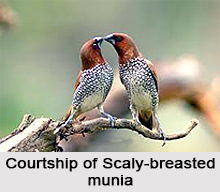 Scaly-Breasted Munia or Spotted Munia is an Indian bird that bears a scientific name "Lonchura punctulata" found in tropical and sub tropical Asia.
Scaly-Breasted Munia or Spotted Munia is an Indian bird that bears a scientific name "Lonchura punctulata" found in tropical and sub tropical Asia.
Description of Scaly-Breasted Munia
Scaly-Breasted Munia was one of the many bird species originally described by Carl Linnaeus in the 1758 10th edition of his Systema Naturae, where it was given the binomial name of Loxia punctulata. Sykes assigned it to the genus Lonchura in the combination Lonchura punctulata in 1823.
Category of Scaly-Breasted Munia
Scaly-Breasted Munia is known in the pet trade as nutmeg mannikin or spice finch, is a sparrow-sized estrildid finch native to tropical Asia. Scaly-Breasted Munia is in the name of the genus Lonchura, it was formally described and named by Carl Linnaeus in 1758.
Structure of Scaly-Breasted Munia
Its name Scaly-Breasted Munia is based on the distinct scale-like feather markings on the breast and belly. The adult is brown above and has a dark conical bill. The species has 11 subspecies across their range and differ slightly in size and colour.
Feeding of Scaly-Breasted Munia
Scaly-Breasted Munia eats mainly grass seeds apart from berries and small insects. Scaly-Breasted Munia forages in flocks and communicate with soft calls and whistles. The species is highly social and may sometimes roost with other species of munias. This species is found in tropical plains and grasslands. Breeding pairs construct dome-shaped nests using grass or bamboo leaves.
 Habitat of Scaly-Breasted Munia
Habitat of Scaly-Breasted Munia
Scaly-Breasted Munia is endemic to Asia and occurs from India and Sri Lanka east to Indonesia and the Philippines. It has been introduced into many other parts of the world and feral populations have established in Puerto Rico and Hispaniola as well as parts of Australia and the United States of America. The bird is listed as of Least Concern by the International Union for Conservation of Nature (IUCN).
Acceptance of Scaly-Breasted Munia
Over its range Scaly-Breasted Munia has been assigned to 11 generally accepted subspecies. These include the nominate form found in the plains of South Asia, including Pakistan, India, Nepal, Bangladesh and Sri Lanka.
Name of Scaly-Breasted Munia
The name of Scaly-Breasted Munia was formerly used for the Indian population. Other populations include subundulata from the eastern Himalayan Mountain Range, yunnanensis of southern China, topela of Thailand, cabanisi of the Philippines and fretensis of Singapore and Sumatra Island populations include nisoria (Java, Bali, Lombok, Sumbawa), particeps (Sulawesi), baweana (Bawean Island), sumbae (Sumba), blasii (Flores, Timor and Tanimbar) and holmesi (Southeast Borneo).
Structure of Scaly-Breasted Munia
Scaly-Breasted Munia is about 11-12 centimetres long and weighs 12-16 grams. The adult has a stubby dark bill typical of grain eating birds, brown upperparts and a dark brown head. The underparts are white with dark scale markings. The sexes are similar, although males have darker markings on the underside and a darker throat than females.
Immature Scaly-Breasted Munia
Immature birds have pale brown upperparts, lack the dark head found in adults, and have uniform buff underparts that can be confused with juveniles of other munia species such as the tricoloured munia (Lonchura malacca) across the Asian and island populations and the black-throated munia (Lonchura kelaarti) in parts of India or Sri Lanka. Populations within their wide distribution range show variations in plumage colour and size.
Roosting Community of Scaly-Breasted Munia
When roosting communally, Scaly-Breasted Munia sits side-by-side in close contact with each other. The outermost bird often jostles towards the centre. Birds in a flock sometimes preen each other, with the soliciting bird usually showing its chin. Allopreening is usually limited to the face and neck. Scaly-Breasted Munia is rarely hostile but birds will sometimes quarrel without any ritualized posturing. The scaly-Breasted Munia produces vocalizations to communicate with its flock.
Breeding of Scaly-Breasted Munia
The breeding season of Scaly-Breasted Munia is during the summer rainy season (mainly June to August in India) but can vary. Laboratory studies have found that long day illumination and high humidity trigger gonadal growth.
Songs of Scaly-Breasted Munia
The song of the male Scaly-Breasted Munia is very soft but complex and variable, audible only at close range. This song described as a jingle consists of a series of high notes followed by a croaky rattle and ending in a slurred whistle. When singing the male sits in what is called the slope posture-erect with the head feathers raised.
Nests of Scaly-Breasted Munia
The nest of Scaly-Breasted Munia is a large domed structure loosely woven from blades of grass, bamboo or other leaves with a side entrance and is placed in a tree or under the eaves of a house. The nest opening is located to face downwind of the most frequent wind direction in northern part of India like Uttar Pradesh, Punjab, Himachal Pradesh and Chandigarh, they preferred isolated Acacia nilotica in non-urban areas but used Thuja orientalis and Polyalthia longifolia in urban gardens.
Eggs of Scaly-Breasted Munia
Scaly-Breasted Munia clutch usually contain 4 to 6 eggs, but can contain up to 10. Both sexes build the nest and incubate the eggs, which hatch in 10 to 16 days. Juveniles typically fledge in three weeks. Both sexes may reach sexual maturity as early as 7 months after birth in captivity.











